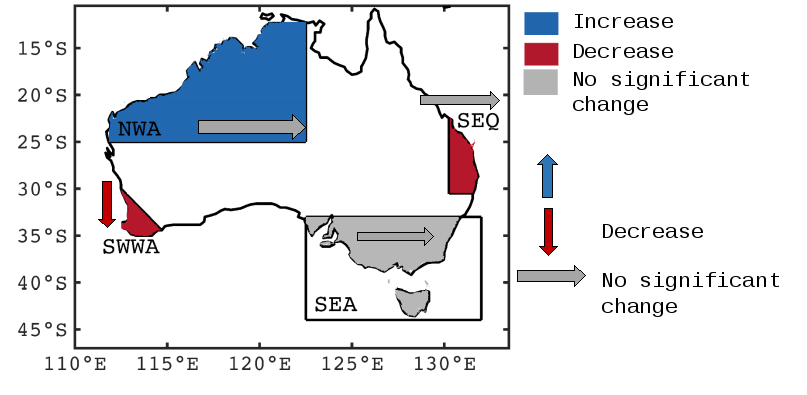What are the past and projected changes to Australia’s rainfall?

Australia’s rainfall is among the most variable rainfall in the world. The highest rainfall is received along the coast; an area that supports more than 84% of the population of the country. Australia has seen some major changes in rainfall patterns in the last 50 years, and these patterns challenge our existing water management strategies. While the rainfall in northwest Australia has increased, there has been a persistent decline in rainfall in the southwest of Western Australia (SWWA) in the last 50 years.

Shading shows changes in rainfall over the past 30 years and the arrows show projected changes for the end of the 21st Century for the regions discussed in the review paper.
Most notably, the recent 13 year-long Millennium drought posed a great threat to the agricultural industry. It is important to understand past changes in rainfall to provide better projections. However, one of the major challenges in studying past trends is that we have only had reliable observations since the beginning of the last century. This period of record taking is not sufficient to allow us to understand a chaotic system like climate. Thus datasets going back several thousand years from now, extracted using paleo techniques, are useful to understand the long-term changes in climate. Studies using long-term paleo data show that the changes seen in the last 50 years are rare even when looking back over a very long time scale. This study reviews the current understanding of past and future Australian rainfall variability and changes. It discusses the reliability of the observational records, both from the instrumental stations available over the past 100 years and paleo data before that.
There are various drivers of Australia’s rainfall; for example, Monsoon, ENSO, cyclones and fronts to name a few. Understanding the influence of climate change on these background drivers is also important when projecting changes in rainfall. Most of these drivers have responded significantly to climate change in the past, and a further change is projected. This implies potential impacts on rainfall. This paper summarises the role of these drivers in the observed rainfall trends and our understanding of future changes. The human influence on temperature is well known; however, the impacts on rainfall are complicated and vary regionally. For example, in the northwest of Australia where an increase in rainfall has been seen over the last 50 years, the future change in this region is not clear. The SWWA is projected to experience continued below average rainfall while predictions of future rainfall changes in SEA remain inconclusive.
In addition to changes in average rainfall, extreme rainfall events (rare, high intensity/high accumulation rainfall events) pose a great threat to society, taking millions of lives and damaging properties. It is of particular interest to understand the changes in extreme rainfall in the past and provide robust projections in the future warmer world. There is a consensus among scientists that extreme rainfall will intensify and become more frequent. We have already started to see signs of that. This implies that we will see increased fatalities if mitigation measures are not taken in advance.
There is still much work needed to improve regional projections as existing tools and climate models fail to produce reliable results due to a lack of understanding, and computing resources. Future research projects that will help enable improvements in rainfall projections are suggested.
Paper: , , , . A review of past and projected changes in Australia’s rainfall. WIREs Clim Change. 2019;e00577. https://doi.org/10.1002/wcc.577
